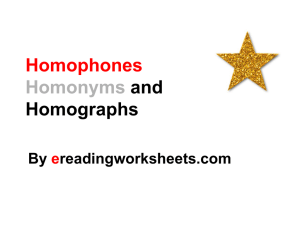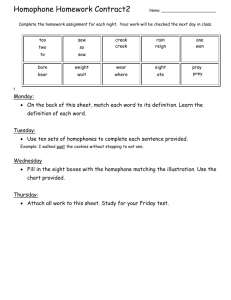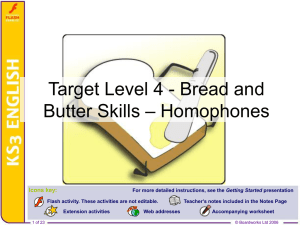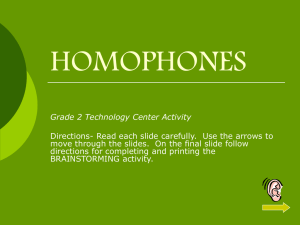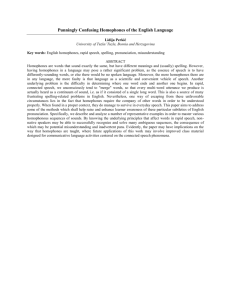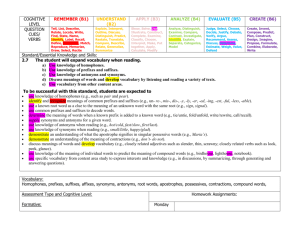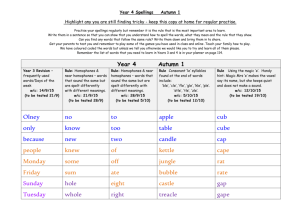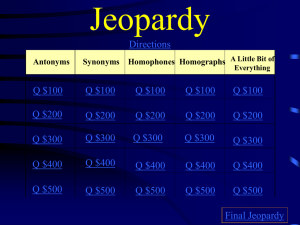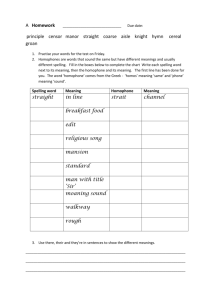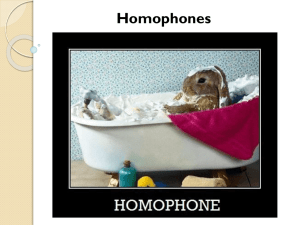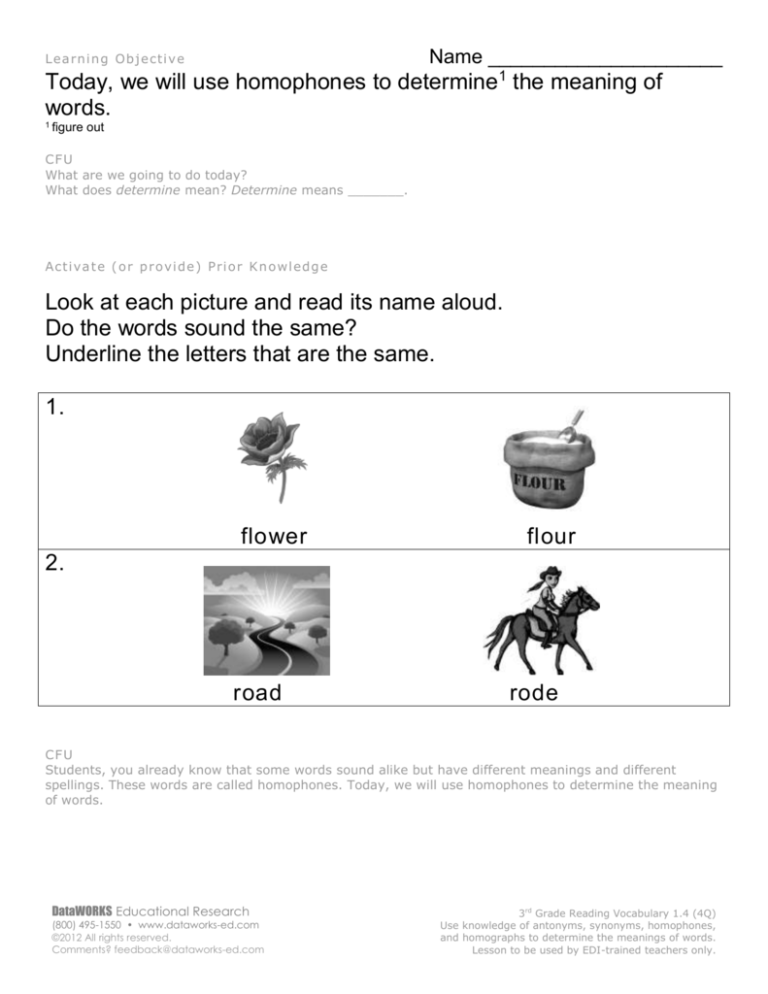
Name _____________________
L ea rn i n g Obj e cti v e
Today, we will use homophones to determine1 the meaning of
words.
1 figure
out
CFU
What are we going to do today?
What does determine mean? Determine means _______.
Acti va t e ( o r p r o vi de ) P ri o r K n o wl edg e
Look at each picture and read its name aloud.
Do the words sound the same?
Underline the letters that are the same.
1.
flower
flour
2.
road
rode
CFU
Students, you already know that some words sound alike but have different meanings and different
spellings. These words are called homophones. Today, we will use homophones to determine the meaning
of words.
DataWORKS Educational Research
(800) 495-1550 • www.dataworks-ed.com
©2012 All rights reserved.
Comments? feedback@dataworks-ed.com
3rd Grade Reading Vocabulary 1.4 (4Q)
Use knowledge of antonyms, synonyms, homophones,
and homographs to determine the meanings of words.
Lesson to be used by EDI-trained teachers only.
Co n c e pt D ev el opm e n t
Homophones are words that have the same sound but different
spellings and definitions2.
Correct spelling helps determine the meaning of homophones.
2
meanings (synonym)
Homophones: Eight/Ate
Eight is the number 8.
There were eight cars in the parking
lot.
Ate is to have eaten food.
We already ate lunch today.
Not examples of homophones:
The bat flies through the air.
The baseball bat is made out of wood.
CFU
Which set of words below are homophones? How do you know?
Why is the other set of words not homophones?
A fly, fly
B pair, pear
What is the difference between the words pair/pear and bat/bat? Explain your answer.
The difference between the words pair/pear and bat/bat is __________________________.
In your own words, what are homophones? Homophones are _________________________.
DataWORKS Educational Research
(800) 495-1550 • www.dataworks-ed.com
©2012 All rights reserved.
Comments? feedback@dataworks-ed.com
3rd Grade Reading Vocabulary 1.4 (4Q)
Use knowledge of antonyms, synonyms, homophones,
and homographs to determine the meanings of words.
Lesson to be used by EDI-trained teachers only.
Ski l l Dev el o pm en t /G u i ded P ra cti c e
Homophones are words that have the same sound but different spellings and
definitions.
Use homophones to determine the meaning of words.
Step #1: Read the homophone definitions.
Step #2: Read the sentence carefully.
a. Identify3 words that help determine which meaning to use. (underline)
Step #3: Identify the correct homophone. (circle and write) Hint: Use words from the
sentence.
Step #4: Read the sentence to determine that you selected the correct spelling of the
homophone.
3
find (synonym)
hear – use your ears to know a sound is being made
here – a place or location
1. Did you _________ your mother when she called you?
some – an unclear amount
sum – a total when adding
2. Our teacher gave us an addition problem and told us to find the _______.
eight – the number 8
ate – to have eaten
3. I went to bed last night at _________o’clock.
bear – a large animal
bare – empty
4. When she looked in the cupboard, it was __________.
CFU
(#2a) How did I/you identify the words that help me/you determine which meaning to use?
(#3) How did I/you identify the correct homophone?
DataWORKS Educational Research
(800) 495-1550 • www.dataworks-ed.com
©2012 All rights reserved.
Comments? feedback@dataworks-ed.com
3rd Grade Reading Vocabulary 1.4 (4Q)
Use knowledge of antonyms, synonyms, homophones,
and homographs to determine the meanings of words.
Lesson to be used by EDI-trained teachers only.
Ski l l Dev el o pm en t /G u i ded P ra cti c e ( c on t i n u ed)
Homophones are words that have the same sound but different spellings and
definitions.
Use homophones to determine the meaning of words.
Step #1: Read the homophone definitions.
Step #2: Read the sentence carefully.
a. Identify words that help determine which meaning to use. (underline)
Step #3: Identify the correct homophone. (circle and write) Hint: Use words from the
sentence.
Step #4: Read the sentence to determine that you selected the correct spelling of the
homophone.
heard – was aware of a sound
herd – a large group of animals
5. I ________ a loud noise when I was outside today.
pair – a set of two
pear – a sweet fruit
6. I received a new __________ of shoes last week.
to – direction
too – more than enough
two – the number 2
7. Gabby is planning ______ go home after the soccer game.
they’re – contraction of they are
their – belonging to people or things
there – in that place
8. They will be coming in ______ family van.
CFU
(#2a) How did I/you identify the words that help me/you determine which meaning to use?
(#3) How did I/you identify the correct homophone?
DataWORKS Educational Research
(800) 495-1550 • www.dataworks-ed.com
©2012 All rights reserved.
Comments? feedback@dataworks-ed.com
3rd Grade Reading Vocabulary 1.4 (4Q)
Use knowledge of antonyms, synonyms, homophones,
and homographs to determine the meanings of words.
Lesson to be used by EDI-trained teachers only.
Rel e va n c e
Homophones are words that have the same sound but different
spellings and definitions.
1. Using homophones to determine the meaning of words will help
you use the correct spelling in your writing.
The boy blew out the candles on his cake.
The girl wore a blue dress to the party.
2. Using homophones to determine the meaning of words will help
you do well on tests.
CFU
Does anyone else have another reason why it is relevant to use homophones to determine the meaning of
words? (pair-share) Why is it relevant to use homophones to determine the meaning of words? You may
give me one of my reasons or one of your own. Which reason is more relevant to you? Why?
DataWORKS Educational Research
(800) 495-1550 • www.dataworks-ed.com
©2012 All rights reserved.
Comments? feedback@dataworks-ed.com
3rd Grade Reading Vocabulary 1.4 (4Q)
Use knowledge of antonyms, synonyms, homophones,
and homographs to determine the meanings of words.
Lesson to be used by EDI-trained teachers only.
Homophones are words that have the same sound but different spellings and
definitions.
Ski l l Cl osu r e
Use homophones to determine the meaning of the words below.
Step #1: Read the homophone definitions.
Step #2: Read the sentence carefully.
a. Identify words that help determine which meaning to use. (underline)
Step #3: Identify the correct homophone. (circle and write) Hint: Use words from the
sentence.
Step #4: Read the sentence to determine that you selected the correct spelling of
the homophone.
close – shut
clothes – something worn to cover the body
1. Can you please ___________ the door?
ant – a small black or red insect
aunt – the sister of your father or mother
2. We found an __________ hill in the garden.
Co n st ru ct e d R e sp on s e Cl o su r e
The flower was yellow and blue.
My mom uses flour to bake cookies.
Why are the underlined words examples of homophones? Explain.
__________________________________________________________________
__________________________________________________________________
Su mm ar y Cl o su r e
What did you learn today about using homophones to determine the meaning of
words? (pair-share)
Day 1 _______________________________________________________________________
_____________________________________________________________________________
Day 2 _______________________________________________________________________
______________________________________________________________________________________
DataWORKS Educational Research
(800) 495-1550 • www.dataworks-ed.com
©2012 All rights reserved.
Comments? feedback@dataworks-ed.com
3rd Grade Reading Vocabulary 1.4 (4Q)
Use knowledge of antonyms, synonyms, homophones,
and homographs to determine the meanings of words.
Lesson to be used by EDI-trained teachers only.
Name __________________________
Homophones are words that have the same sound but different spellings and
definitions.
In d ep en d en t P ra cti c e
Use homophones to determine the meaning of words.
Step #1: Read the homophone definitions.
Step #2: Read the sentence carefully.
a. Identify words that help determine which meaning to use. (underline)
Step #3: Identify the correct homophone. (circle and write) Hint: Use words from the
sentence.
Step #4: Read the sentence to determine that you selected the correct spelling of the
homophone.
week – seven days
weak – not strong
1. I only have a short time to study because my test is in one ________!
meat – flesh of an animal eaten for food
meet – to see or talk to someone for the first time
2. The hunter ate the _________ that he had caught in the forest.
wait – to stay somewhere until something happens
weight – how heavy something is
3. Please ____________ here. The principal will see you soon.
threw – have tossed something
through – in one side and out the other
4. I had to walk _________ the cafeteria to get to the playground.
DataWORKS Educational Research
(800) 495-1550 • www.dataworks-ed.com
©2012 All rights reserved.
Comments? feedback@dataworks-ed.com
3rd Grade Reading Vocabulary 1.4 (4Q)
Use knowledge of antonyms, synonyms, homophones,
and homographs to determine the meanings of words.
Lesson to be used by EDI-trained teachers only.
In d ep en d en t P ra cti c e ( co n ti n u ed)
Homophones are words that have the same sound but different spellings and
definitions.
Use homophones to determine the meaning of words.
Step #1: Read the homophone definitions.
Step #2: Read the sentence carefully.
a. Identify words that help determine which meaning to use. (underline)
Step #3: Identify the correct homophone. (circle and write) Hint: Use words from the
sentence.
Step #4: Read the sentence to determine that you selected the correct spelling of the
homophone.
toad – an animal that looks like a large frog
towed – to have pulled a car or truck with a rope or chain
5. We had to have our car __________ to the repair shop.
hair – what grows out of your head
hare – a rabbit
6. The dog got very excited when he saw the __________. He likes to
chase animals.
to – direction
too – more than enough
two – the number 2
7. He had _______ cookies for lunch.
they’re – contraction of they are
their – belonging to people or things
there – in that place
8. My parents will stay _________ at the campsite.
DataWORKS Educational Research
(800) 495-1550 • www.dataworks-ed.com
©2012 All rights reserved.
Comments? feedback@dataworks-ed.com
3rd Grade Reading Vocabulary 1.4 (4Q)
Use knowledge of antonyms, synonyms, homophones,
and homographs to determine the meanings of words.
Lesson to be used by EDI-trained teachers only.
Name _________________________
Homophones are words that have the same sound but different spellings and
definitions.
P eri odi c R evi ew 1
Use homophones to determine the meaning of words.
Step #1: Read the homophone definitions.
Step #2: Read the sentence carefully.
a. Identify words that help determine which meaning to use. (underline)
Step #3: Identify the correct homophone. (circle and write) Hint: Use words from the
sentence.
Step #4: Read the sentence to determine that you selected the correct spelling of the
homophone.
eight – the number 8
ate – to have eaten
1. School begins at ________o’clock.
ant – a small black or red insect
aunt – the sister of your father or mother
2. My favorite _________ took me to the movies for my birthday.
some – an unclear amount
sum – a total when adding
3. I gave _________ of my candy from Halloween to my cousin.
week – seven days
weak – not strong
4. The wrestler was ___________ after he hurt himself.
to – direction
too – more than enough
two – the number 2
5. You put ______ much salt in the soup.
DataWORKS Educational Research
(800) 495-1550 • www.dataworks-ed.com
©2012 All rights reserved.
Comments? feedback@dataworks-ed.com
3rd Grade Reading Vocabulary 1.4 (4Q)
Use knowledge of antonyms, synonyms, homophones,
and homographs to determine the meanings of words.
Lesson to be used by EDI-trained teachers only.
Name _________________________
Homophones are words that have the same sound but different spellings and
definitions.
P eri odi c R evi ew 2
Use homophones to determine the meaning of words.
Step #1: Read the homophone definitions.
Step #2: Read the sentence carefully.
a. Identify words that help determine which meaning to use. (underline)
Step #3: Identify the correct homophone. (circle and write) Hint: Use words from the
sentence.
Step #4: Read the sentence to determine that you selected the correct spelling of the
homophone.
wait – to stay somewhere until something happens
weight – how heavy something is
1. She had so many books that the _______ of her backpack almost made
her fall.
close – to shut
clothes – something worn to cover the body
2. I grew so much over the summer, I needed new ________ to wear for
school.
toad – an animal that looks like a frog
towed – to have pulled a car or truck with a rope or chain
3. My friend has a pet _________ named Kermit.
bear – a large animal
bare – empty
4. She couldn’t wait to plant grass and trees in her __________ backyard.
they’re – contraction of they are
their – belonging to people or things
there – in that place
5. Mother said _________ coming over after lunch.
DataWORKS Educational Research
(800) 495-1550 • www.dataworks-ed.com
©2012 All rights reserved.
Comments? feedback@dataworks-ed.com
3rd Grade Reading Vocabulary 1.4 (4Q)
Use knowledge of antonyms, synonyms, homophones,
and homographs to determine the meanings of words.
Lesson to be used by EDI-trained teachers only.
Name _________________________
Homophones are words that have the same sound but different spellings and
definitions.
P eri odi c R evi ew 3
Use homophones to determine the meaning of words.
Step #1: Read the homophone definitions.
Step #2: Read the sentence carefully.
a. Identify words that help determine which meaning to use. (underline)
Step #3: Identify the correct homophone. (circle and write) Hint: Use words from the
sentence.
Step #4: Read the sentence to determine that you selected the correct spelling of the
homophone.
hear – use your ears to know a sound is being made
here – a place or location
1. Bring your homework ___________ so I can help you.
meat – flesh of an animal eaten for food
meet – to see or talk to someone for the first time
2. I am so nervous to _________ my new teacher.
heard – was aware of a sound
herd – a large group of animals
3. The _________ of buffalo __________ a noise that made them run away.
threw – have tossed something
through – in one side and out the other
4. I __________ the ball ____________ the crowd of people, all the way to
the parking lot!
buy – to purchase something
by – to go past
bye – short way to say goodbye
5. We went to the store to ________ some milk and bread.
DataWORKS Educational Research
(800) 495-1550 • www.dataworks-ed.com
©2012 All rights reserved.
Comments? feedback@dataworks-ed.com
3rd Grade Reading Vocabulary 1.4 (4Q)
Use knowledge of antonyms, synonyms, homophones,
and homographs to determine the meanings of words.
Lesson to be used by EDI-trained teachers only.
Blank Page
DataWORKS Educational Research
(800) 495-1550 • www.dataworks-ed.com
©2012 All rights reserved.
Comments? feedback@dataworks-ed.com
3rd Grade Reading Vocabulary 1.4 (4Q)
Use knowledge of antonyms, synonyms, homophones,
and homographs to determine the meanings of words.
Lesson to be used by EDI-trained teachers only.

